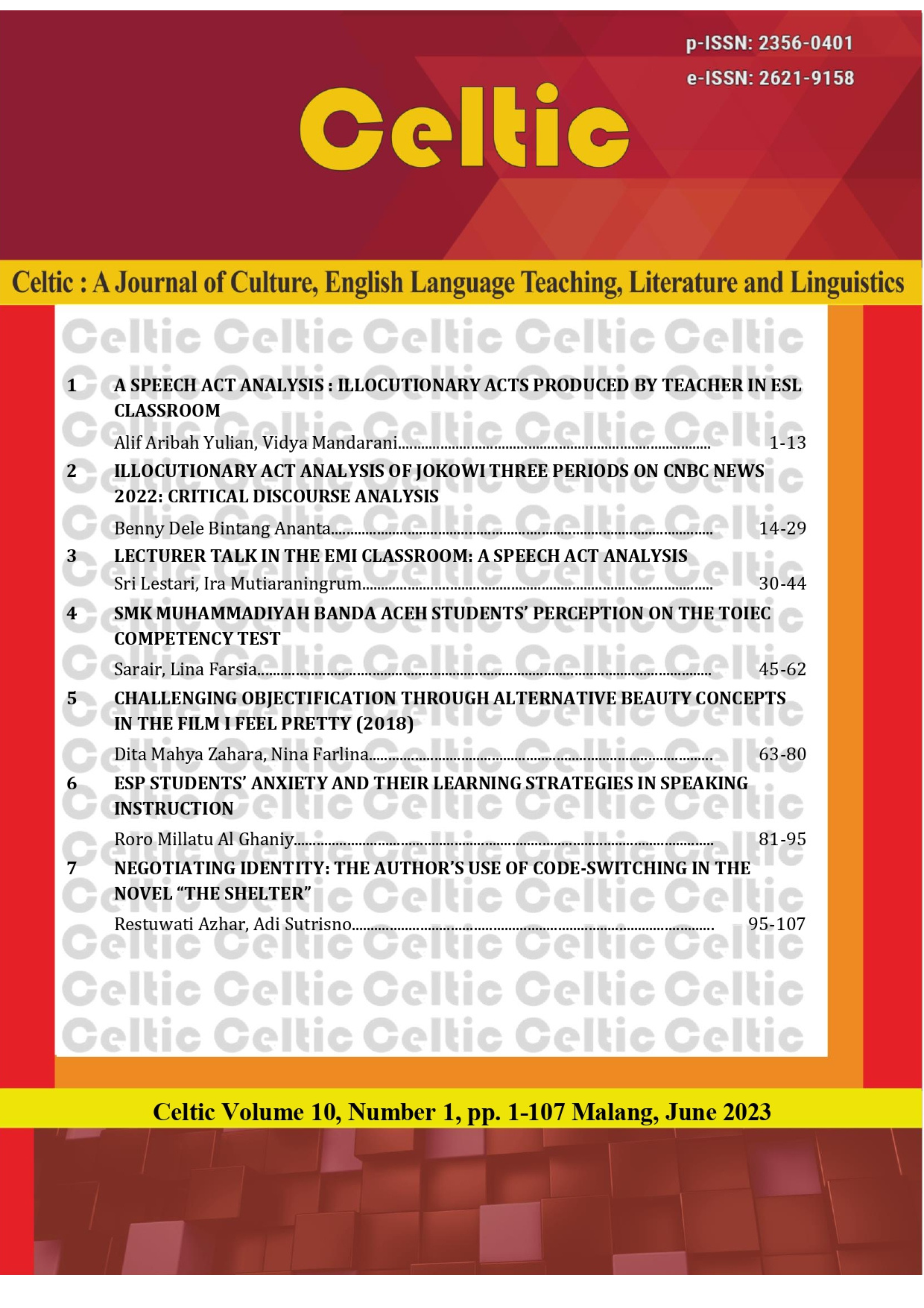FLSP STUDENTS’ ANXIETY AND THEIR LEARNING STRATEGIES IN SPEAKING CLASS
DOI:
https://doi.org/10.22219/celtic.v10i1.25739Abstract
This study investigated the Foreign Language for Specific Purposes (FLSP) students' anxiety and learning strategies in speaking instruction. To gain insight into FLSP students' speaking anxiety and learning strategies, this study applied a descriptive qualitative research design. A Foreign Language Classroom Anxiety Scale (FLCAS) questionnaire and a semi-structured interview were used to collect data from 26 FLSP students for the study. The results were described in percentages and elaborated in the description. The results regarding the students' anxiety revealed that 7 out of 26 students (27%) experienced low anxiety, 17 out of 26 students (65%) encountered moderate anxiety, and 2 (8%) students experienced high anxiety. Furthermore, the results regarding the students' learning strategies showed that strategies such as preparation, practicing before speaking, and positive thinking helped students reduce anxiety in FLSP speaking performance. Implementing the appropriate strategies in FLSP speaking is significant as learning FLSP is more complex than general or academic English as it involves numerous foreign terms.
Downloads
References
Ahmed, N. F. (2016). An Exploration of Speaking Anxiety with Kurdish University EFLLearners. Journal of Education and Practice, 7(27), 99–106.
Akkakoson, S. (2016). Speaking Anxiety in English. Malaysian Journal of Learning and Instruction, 13(1), 63–82.
Anandari, C. L. (2015). Indonesian Efl Students’ Anxiety in Speech Production: Possible Causes and Remedy. TEFLIN Journal - A Publication on the Teaching and Learning of English, 26(1), 1. https://doi.org/10.15639/teflinjournal.v26i1/1-16
Brown, H. D., & Abeywickrama, P. (2004). Language assessment. Principles and Classroom Practices. White Plains, NY: Pearson Education.
Chou, M. H. (2018). Speaking Anxiety and Strategy Use for Learning English as a Foreign Language in Full and Partial English-Medium Instruction Contexts. TESOL Quarterly, 52(3), 611–633. https://doi.org/10.1002/tesq.455
Clark, D., & Beck, A. (2012). The anxiety and worry work book. The Guildfold Publication. Inc.
Debreli, E., & Demirkan, S. (2015). Sources and levels of foreign language speaking anxiety of English as a foreign language university students with regard to language proficiency and gender. International Journal of English Language Education, 4(1), 49–62.
Erdiana, N., Daud, B., Sari, D. F., & Dwitami, S. K. (2020). A study of anxiety experienced by efl students in speaking performance. Studies in English Language and Education, 7(2), 334–346. https://doi.org/10.24815/siele.v7i2.16768
Gani, S. A., Fajrina, D., & Hanifa, R. (2015). Students’ learning strategies for developing speaking ability. Studies in English Language and Education, 2(1), 16–28.
HORWITZ, E. K., HORWITZ, M. B., & COPE, J. (1986). Foreign Language Classroom Anxiety. The Modern Language Journal, 70(2), 125–132. https://doi.org/10.1111/j.1540-4781.1986.tb05256.x
Kasbi, S., & Elahi Shirvan, M. (2017). Ecological understanding of foreign language speaking anxiety: emerging patterns and dynamic systems. Asian-Pacific Journal of Second and Foreign Language Education, 2(1). https://doi.org/10.1186/s40862-017-0026-y
Kondo, D. S., & Ying-Ling, Y. (2004). Strategies for coping with language anxiety: The case of students of English in Japan. Elt Journal, 58(3), 258–265.
Lucas, R. I., Miraflores, E., & Go, D. (2011). Philippine ESL Journal, Vol. 7, July 2011. Philippine ESL Journal, 7(July), 94–119.
Miles, M. B., Huberman, A. M., & Saldaña, J. (2014). Qualitative Data Analysis A methods Source Book Third Edition. USA: SAGE Publications, Inc.
Nunan, D. (1991). Language teaching methodology (Vol. 192). New York: prentice hall.
Richards, J. C. (2008). Teaching listening and speaking (Vol. 35, Issue 4). Cambridge university press Cambridge.
Sari, D. (2016). STUDENTS’STRATEGIES IN REDUCING SPEAKING ANXIETY. Proceedings of EEIC, 1(2), 125–130.
Sholikhi, F. (2021). Business administration students’ anxiety in speaking skill practice. Celtic: A Journal of Culture, English Language Teaching, Literature and Linguistics, 8(1), 22–32. https://doi.org/10.22219/celtic.v8i1.14132
Shumin, K. (2002). Factors to consider: Developing adult EFL students’ speaking abilities. Methodology in Language Teaching: An Anthology of Current Practice, 12(35), 204–211.
Takkaç–Tulgar, A. (2018). Speaking anxiety of foreign learners of Turkish in target context. International Online Journal of Education and Teaching (IOJET), 5(2), 313–332.
Tuan, N. H., & Mai, T. N. (2015). Factors affecting students’ speaking performance at Le Thanh Hien high school. Asian Journal of Educaitonal Research, 3(2), 8–23.
Waters, A. (Ed.). (2003). Oxford Learner's Pocket Dictionary (Third Edition). Oxford University Press.
Widhayanti, Z. (2018). English Department Students’ Learning Strategies to Overcome Speaking Anxiety. Retain, 6(2), 60–67.
Zhiping, D., & Paramasivam, S. (2013). Anxiety of speaking English in class among international students in a Malaysian university. International Journal of Education and Research, 1(11), 1–16.
Downloads
Published
How to Cite
Issue
Section
License
Copyright (c) 2023 Roro Millatu Al Ghaniy

This work is licensed under a Creative Commons Attribution-ShareAlike 4.0 International License.
- Authors retain copyright to publish without restrictions and grant the journal right of first publication with the work simultaneously licensed under a Creative Commons Attribution License that allows others to share the work with an acknowledgement of the work's authorship and initial publication in this journal.
- Authors are able to enter into separate, additional contractual arrangements for the non-exclusive distribution of the journal's published version of the work (e.g., post it to an institutional repository or publish it in a book), with an acknowledgement of its initial publication in this journal.
- Authors are permitted and encouraged to post their work online (e.g., in institutional repositories or on their website) prior to and during the submission process, as it can lead to productive exchanges, as well as earlier and greater citation of published work.














